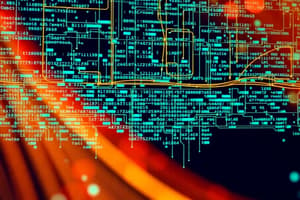Podcast
Questions and Answers
Which of the following best describes the historical progression of networking models?
Which of the following best describes the historical progression of networking models?
- From wireless networks to wired networks.
- From enterprise networks to smaller local networks.
- From proprietary models to open TCP/IP models. (correct)
- From open TCP/IP models to proprietary models.
In the updated TCP/IP networking model, which layer is responsible for providing reliable data transfer between two applications?
In the updated TCP/IP networking model, which layer is responsible for providing reliable data transfer between two applications?
- Internet Layer
- Network Layer
- Transport Layer (correct)
- Data Link Layer
Which of the following protocols operates at the Application Layer of the TCP/IP model?
Which of the following protocols operates at the Application Layer of the TCP/IP model?
- TCP
- IP
- HTTP (correct)
- Ethernet
What is the primary function of the Internet Layer in the TCP/IP model?
What is the primary function of the Internet Layer in the TCP/IP model?
Which layer of the TCP/IP model is responsible for the physical transmission of data over a network?
Which layer of the TCP/IP model is responsible for the physical transmission of data over a network?
What is the purpose of data encapsulation in the TCP/IP model?
What is the purpose of data encapsulation in the TCP/IP model?
A network administrator is troubleshooting a connectivity issue between two hosts on different networks. At which layer of the TCP/IP model should they primarily investigate routing protocols?
A network administrator is troubleshooting a connectivity issue between two hosts on different networks. At which layer of the TCP/IP model should they primarily investigate routing protocols?
Which of the following is NOT a typical function of the Data Link Layer?
Which of the following is NOT a typical function of the Data Link Layer?
Which of the following best describes 'same-layer interaction' in the context of the TCP/IP model?
Which of the following best describes 'same-layer interaction' in the context of the TCP/IP model?
Which of the following describes 'adjacent-layer interaction'?
Which of the following describes 'adjacent-layer interaction'?
In the postal service analogy for network routing, what component is most similar to a router?
In the postal service analogy for network routing, what component is most similar to a router?
What is the role of a protocol in same-layer interaction?
What is the role of a protocol in same-layer interaction?
What is the main purpose of TCP when providing services to HTTP?
What is the main purpose of TCP when providing services to HTTP?
When data is encapsulated, what term is used to describe the Data Link Layer header and trailer?
When data is encapsulated, what term is used to describe the Data Link Layer header and trailer?
What is the correct order of data encapsulation in the TCP/IP model?
What is the correct order of data encapsulation in the TCP/IP model?
Which layer of the OSI model is responsible for defining data formats, such as JPEG and ASCII?
Which layer of the OSI model is responsible for defining data formats, such as JPEG and ASCII?
Which layer of the OSI model is responsible for logical addressing and routing?
Which layer of the OSI model is responsible for logical addressing and routing?
Which layer of the OSI model defines how to start, control, and end conversations (sessions)?
Which layer of the OSI model defines how to start, control, and end conversations (sessions)?
Which of the following devices operates at the Network Layer (Layer 3) of the OSI model?
Which of the following devices operates at the Network Layer (Layer 3) of the OSI model?
Which of the following devices primarily operates at the Data Link Layer (Layer 2) of the OSI model?
Which of the following devices primarily operates at the Data Link Layer (Layer 2) of the OSI model?
Which of the following protocols is associated with the Application Layer (Layers 5-7) of the OSI model?
Which of the following protocols is associated with the Application Layer (Layers 5-7) of the OSI model?
What is the function of the Physical Layer (Layer 1) in the OSI model?
What is the function of the Physical Layer (Layer 1) in the OSI model?
Regarding OSI encapsulation, what information does the L4H (Layer 4 Header) contain?
Regarding OSI encapsulation, what information does the L4H (Layer 4 Header) contain?
Regarding OSI encapsulation, which layer adds both a header and a trailer to the data?
Regarding OSI encapsulation, which layer adds both a header and a trailer to the data?
How do the TCP/IP and OSI models compare regarding the Application Layer?
How do the TCP/IP and OSI models compare regarding the Application Layer?
Flashcards
TCP/IP Model
TCP/IP Model
A networking model consisting of layers: Application, Transport, Internet, and Link.
Data Encapsulation
Data Encapsulation
The initial step in sending data, involving adding headers to the data as it moves down the TCP/IP layers.
Routing
Routing
The process of forwarding packets between networks.
OSI Application Layer
OSI Application Layer
Signup and view all the flashcards
OSI Presentation Layer
OSI Presentation Layer
Signup and view all the flashcards
OSI Session Layer
OSI Session Layer
Signup and view all the flashcards
OSI Transport Layer
OSI Transport Layer
Signup and view all the flashcards
OSI Network Layer
OSI Network Layer
Signup and view all the flashcards
OSI Data Link Layer
OSI Data Link Layer
Signup and view all the flashcards
OSI Physical Layer
OSI Physical Layer
Signup and view all the flashcards
Application Layer
Application Layer
Signup and view all the flashcards
Transport Layer
Transport Layer
Signup and view all the flashcards
Internet Layer
Internet Layer
Signup and view all the flashcards
Link Layer
Link Layer
Signup and view all the flashcards
Study Notes
- Chapter 1 introduces TCP/IP networking.
- The objectives include perspectives on networking, the TCP/IP networking model, and data encapsulation terminology.
Two Major Branches of Networking
- Enterprise networks are one of the major branches.
TCP/IP Networking Model
- The TCP/IP model has evolved from proprietary models to an open standard.
- In the 1980's, networking was dominated by proprietary models like IBM and DEC.
- By the 2000's TCP/IP became prominent, becoming the standard.
TCP/IP Networking Models
- The original TCP/IP model has four layers: Application, Transport, Internet, and Link.
- The updated TCP/IP model consists of five layers: Application, Transport, Network, Data Link, and Physical layers.
TCP/IP Architectural Model and Example Protocols
- Application Layer protocols include HTTP, POP3, and SMTP.
- Transport Layer protocols are TCP and UDP.
- Internet Layer protocols include IP and ICMP.
- Data Link and Physical Layer protocols are Ethernet, 802.11 (Wi-Fi), and TCP/IP.
HTTP (Hypertext Transfer Protocol)
- HTTP involves a Web server (Larry) and a Web browser (Bob).
- The browser requests a web page from the server.
- The server responds with the requested file.
HTTP Request, Reply, and Data
- The browser sends an HTTP Get Request for a page.
- The server replies with an HTTP header indicating "OK" and the "home.htm" data.
- Additional data can be sent in subsequent messages.
TCP/IP Transport Layer
- It provides error-recovery services to HTTP.
- TCP assigns sequence numbers to data packets.
- If a packet is lost, TCP requests the next packet.
Same-Layer and Adjacent-Layer Interaction
- Same-layer interaction involves two computers communicating using a protocol.
- The protocol defines a header that communicates what each computer wants to do.
- Adjacent-layer interaction, a lower layer provides a service to the layer just above and implents the function.
Routing
- Postal service forwarding illustrates routing principles.
Simple TCP/IP Network
- Components include devices with IP addresses and routers.
Basic Routing Example
- Data packets are forwarded (routed) through networks.
Ethernet
- Ethernet for IP Packet Forwarding to Router.
- The letters LH and LT stand for link header and link trailer, respectively, and refer to the data link layer header and trailer.
- An IP packet is encapsulated into an ethernet frame and decapsulated by the destination.
Data Encapsulation
- Step 1: Data
- Step 2: TCP
- Step 3: IP
- Step 4: Data Link
- Step 5: Physical
Perspective on Encapsulation and Data
- The TCP segment includes TCP and Data.
- The IP packet includes IP and Data.
- The Ethernet frame includes LH (Link Header), Data, and LT (Link Trailer).
OSI Networking Model
- The OSI model has 7 layers: Application, Presentation, Session, Transport, Network, Data Link, and Physical.
- The TCP/IP model collapses the Application, Presentation, and Session layers into a single Application layer.
- The OSI model's Network layer corresponds to the Internet layer in TCP/IP.The Link layer of TCP/IP combines Data Link and Physical layers from the OSI model.
OSI Reference Model Layer Definitions
- Application Layer: Provides an interface for communication software and applications, defining processes for user authentication.
- Presentation Layer: Defines and negotiates data formats like ASCII, EBCDIC, JPEG, also defining encryption as a service.
- Session Layer: Defines how to initiate, control, and terminate conversations (sessions).
- Transport Layer: Provides a range of services.
- Network Layer: Defines logical addressing, routing (forwarding), and path determination on how devices forward packets.
- Data Link Layer: Defines the rules for when a device can send data over a medium and the format of headers and trailers.
- Physical Layer: Specifies the physical characteristics of the transmission medium.
OSI Reference Model Devices and Protocols
- Application Layer: Uses protocols like Telnet, HTTP, FTP, SMTP, SNMP; devices include hosts and firewalls.
- Transport Layer: Uses TCP and UDP; devices are hosts and firewalls.
- Network Layer: Uses IP; the primary device is a router.
- Data Link Layer: Uses Ethernet(IEEE 802.3) and HDLC; devices include LAN switches, wireless access points, and modems.
- Physical Layer: Uses RJ-45 and Ethernet (IEEE 802.3); uses LAN hubs, LAN repeaters, and cables.
OSI Encapsulation and Protocol Data Units
- At L7: L7Header + Data = L7PDU
- At L6: L6Header + Data = L6PDU
- At L5: L5Header + Data = L5PDU
- At L4: L4Header + Data = L4PDU
- At L3: L3Header + Data = L3PDU
- At L2: L2Header + Data + L2Trailer = L2PDU
Studying That Suits You
Use AI to generate personalized quizzes and flashcards to suit your learning preferences.




